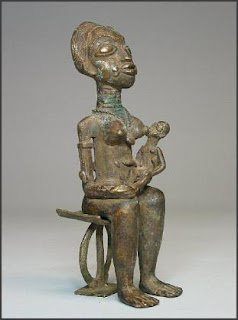ASANTE (ACHANTI, ASHANTE, ASHANTI) Ghana
meaning "Akua's child", since "ba" meant child. She soon became pregnant and her daughter grew up with the doll.
The legend and tradition still live on today...
If an Akan/Asante woman had difficulty conceiving she would be encouraged to visit a local shrine accompanied by a senior woman in her family. There she might purchase a figure such as this, which would be placed for a period on the altar, later to be reclaimed by the woman along with certain medicines. The sculpture was then carried, fed, bathed, and otherwise cared for by the woman as if it was a living baby. It was thought that in doing this the woman would have a better chance to have a healthy and beautiful baby. Once the woman conceived and had a successful delivery, she would return the figure to the shrine as a form of offering. If the child died, the akua’ba might be kept by the woman as a memorial.
The symbolism of these dolls is specific: “The flat, disk like head is a strongly exaggerated conception of the Akan ideal of beauty:
 |
| Asante akua’ba doll (Ghana) |
beauty and prosperity…the small scars seen on the faces of many akua’ba are those made for medicinal purposes as protection against convulsions. Most Asante akua’ba have abstracted, horizontal arms and a cylindrical torso with breasts and a navel, but ending in a base rather than human legs.
Sources: Sotheby's, AFRICA - The Art of A Continent, The Royal Art of Africa, and



.jpg)

+wood.jpg)


